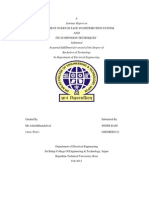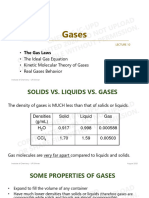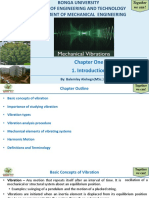iGCSE CIE Co-ordinated Science 0654 (2019-2021 Syllabus) Formula List Compiled by J.
Wilson January 2020
Biology
Microscopy
Actual size = image size
magni0ca1on
Chemistry
General
Number of neutrons = nucleon (mass) number – atomic number
Quan0ta0ve chemistry - Moles
SOLIDS: Number of moles (mol.) = mass (g) or mass (g) n=m = m
Ar (gmol-1) Mr (gmol-1) Ar Mr
LIQUIDS: Number of moles (mol.) = concentra1on (moldm-3) × volume (dm3) n = CV
-3 3 -3 3
LIQUIDS: Concentra1on (moldm ) × volume (dm ) = concentra1on (moldm ) × volume (dm ) C1V1 = C2V2
GASES: Volume of a gas (m3) = number of moles (mol.) × 24 (m3mol-1) V = 24n
(at room temperature and pressure)
Physics
General
Average speed (ms-1) = distance (m)
1me (s)
Average velocity (ms-1) = displacement (m) v=s
1me (s) t
Accelera1on (ms-2) = 0nal velocity (ms-1) – ini1al velocity (ms-1) a = v-u
1me (s) t
Weight (N) = mass (kg) × gravita1onal 0eld strength (ms-2) F = mg
Note: Earth’s gravita>onal ?eld strength = 10 ms-2
Force (N) = mass (kg) × accelera1on (ms-2) F = ma
-3
Density (kgm ) = mass (kg) ρ=M
volume (m3) V
Hooke’s law: Force (N) = constant (Nm-1) × extension (m) F = kx
Pressure (Pa) = force (N) P=F
area (m2) A
Fluid Pressure (Pa) = density (kgm-3) × gravita1onal 0eld strength (ms-2 or Nkg-1) × height (m) P = ρgh
Work (J) = force (N) × distance moved (m) ΔE = Fd
Power (W) = work (J) P = ΔE
1me (s) t
Kine1c Energy (J) = ½ × mass (kg) × velocity2 (ms-1) KE = ½mv2
Gravita1onal poten1al energy (J) GPE = mgh
= mass (kg) × gravita1onal 0eld strength (ms-2 or Nkg-1) × height (m)
E]ciency (%) = useful power output (W) × 100 E]ciency = Pout
total power input (W) Pin
E]ciency (%) = useful energy output (J) × 100 E]ciency = Eout
total energy input (J) Ein
Moment (Nm) = force (N) × perpendicular distance from pivot (m) M = Fd
Sum of clockwise moments (Nm) = sum of an1clockwise moments (Nm) F1d1 = F2d2
�Thermal
Boyle’s Law for changes in gas pressure at constant temperature : P1V1 = P2V2
pressure1 (Pa) × volume1 (m3) = pressure2 (Pa)× volume2 (m3) or
or PV = constant
pressure (Pa) × volume (m3) = constant
Energy (J) = mass (kg) × speci0c heat capacity (Jkg-1°C-1) × temperature change (°C) E = mcΔT
Electricity
Current (A) = charge (C) I=Q
1me (s) t
Voltage (V) = energy transferred (J) V=E
charge (C) Q
Voltage (V) = current (A) × resistance (Ω) V = IR
Power (W) = current (A) × voltage (V) P = IV
2
Power (W) = current (A) × resistance (Ω) P = I2R
Energy transferred (J) = current (A) × voltage (V) × 1me (s) ΔE = IVt
Energy transferred (J) = power (W) × 1me (s) ΔE = Pt
Resistors in series: Total Resistance (Ω) = sum of individual resistors (Ω) RTOTAL = R1+R2+R3+...Rn
Resistors in parallel: 1 = 1
total resistance (Ω) sum of individual resistors (Ω)
Resistance (Ω) = resis1vity (Ωm) × length (m) R = ρl
area (m2) A
Note: since wires have a circular cross sec>on, area = π × radius 2
Transformers: voltage in secondary coil (V) = turns on secondary coil Vs = Ns
voltage in primary coil (V) turns on primary coil Vp Np
Transformers: voltage in primary coil (V) = current in secondary coil (A) Vp = Is
voltage in secondary coil (V) current in primary coil (A) Vs Ip
Waves
Wave speed (ms-1) = frequency (Hz) × wavelength (m) c = fλ
Frequency (Hz) = 1 F=1
Period (s) T
Refrac1ve index = sine of the angle of incidence, i n = sini
sine of the angle of refrac1on, r sinr
Refrac1ve index = speed of light in vacuum n = cv
speed of light in material cm
Refrac1ve index = 1 n= 1
sine of cri1cal angle sinc
Nuclear
Radioac1ve alpha decay:
Radioac1ve beta decay:
Radioac1ve gamma decay:
Energy (J) = mass defect (kg) × speed of light2 (ms-1) E = mc2

















































































